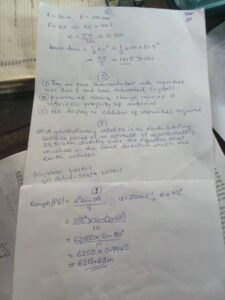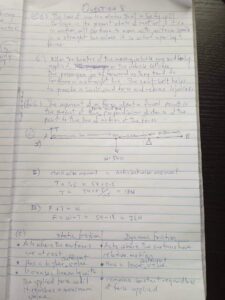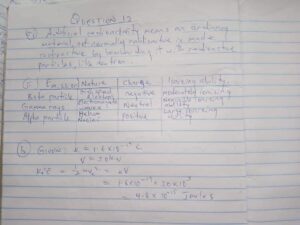Waec 2022 physics questions and answers
OBJECTIVES:
1-10: BCABBDDACA
11-20: CABCBDBDBD
21-30: ABCCBBAADA
31-40: BCDBCBACDA
41-50: DACBDDDBAA
ESSAY:
(2)
(i) Their electrical conductivity is low
(ii) They are pure semi conductors with impurities less than 1 and have tetravalent crystals
(iii) Charges are obtained as a result of thermal excitation.
(No4)

(5a)
A geostationary satellite is an earth-orbiting satellite, placed at an altitude of approximately 35,800 kilometers (22,300 miles) directly over the equator, that revolves in the same direction the earth rotates (west to east).
(5b)
– Gas Lasers
– Solid-State Lasers.
– Fiber Lasers.
(7)
MAGNETIC MATERIAL
1. Magnetic materials are materials that a magnet will attract to itself when placed near a magnet (or when placed in its field).
NON MAGNETIC MATERIAL
1. Non-magnetic materials that will not experience any magnetic force when placed near a magnet, in other words, it will not be attracted to the magnet.
MAGNETIC MATERIAL
2. The magnetic state of magnetic materials are aligned either parallel or antiparallel arrangements hence they can respond to a magnetic field when they are under the influence of an external magnetic field.
NON MAGNETIC MATERIAL
2. The magnetic state of non-magnetic materials are arranged in a random manner in such a way that the magnetic movements of these domains are cancelled out. Hence, they do not respond to a magnetic field.
MAGNET MATERIAL
3. Magnetic materials are used to make permanent magnets, as it can be magnetised by a magnet.
NON MAGNET MATERIAL
3. Non-magnetic materials can never be magnetised by a magnet therefore, it can never become a magnetised material.
8ai
law of inertia, also called Newton’s first law, postulate in physics that, if a body is at rest or moving at a constant speed in a straight line, it will remain at rest or keep moving in a straight line at constant speed unless it is acted upon by a force.
8bi
The Moment of a force is a measure of its tendency to cause a body to rotate about a specific point or axis
11b
Latent heat (also known as latent energy or heat of transformation) is energy released or absorbed, by a body or a thermodynamic system, during a constant-temperature process — usually a first-order phase transition.
Latent heat can be understood as energy in hidden form which is supplied or extracted to change the state of a substance without changing its temperature. Examples are latent heat of fusion and latent heat of vaporization involved in phase changes, i.e. a substance condensing or vaporizing at a specified temperature and pressure.


Answers Loading………
NOTE: If you are yet to subscribe kindly pay now because this post is locked. Send #500 MTN to 08063608463.

